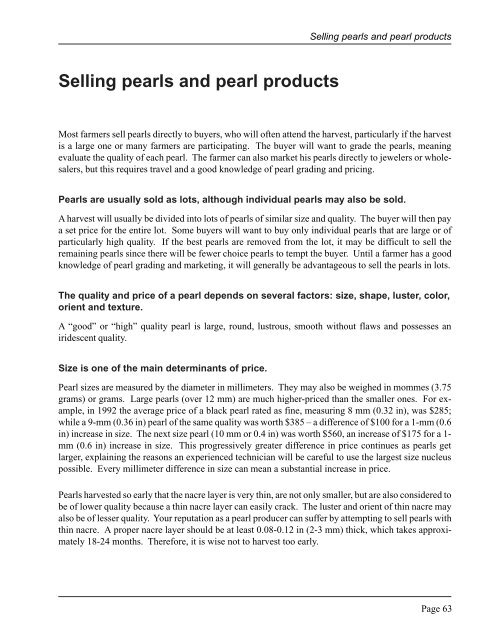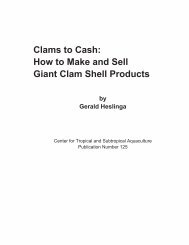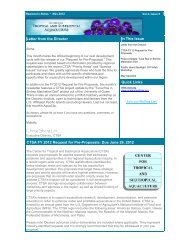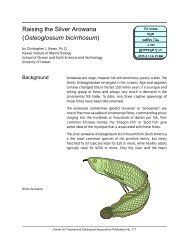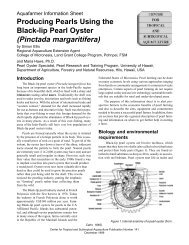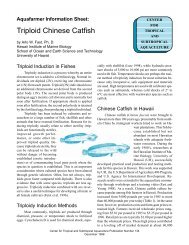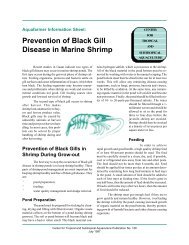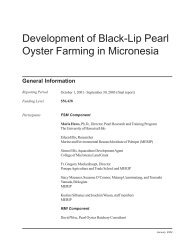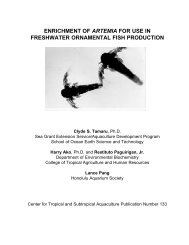The Basic Methods of Pearl Farming: A Layman's Manual - CTSA
The Basic Methods of Pearl Farming: A Layman's Manual - CTSA
The Basic Methods of Pearl Farming: A Layman's Manual - CTSA
You also want an ePaper? Increase the reach of your titles
YUMPU automatically turns print PDFs into web optimized ePapers that Google loves.
Selling pearls and pearl productsSelling pearls and pearl productsMost farmers sell pearls directly to buyers, who will <strong>of</strong>ten attend the harvest, particularly if the harvestis a large one or many farmers are participating. <strong>The</strong> buyer will want to grade the pearls, meaningevaluate the quality <strong>of</strong> each pearl. <strong>The</strong> farmer can also market his pearls directly to jewelers or wholesalers,but this requires travel and a good knowledge <strong>of</strong> pearl grading and pricing.<strong>Pearl</strong>s are usually sold as lots, although individual pearls may also be sold.A harvest will usually be divided into lots <strong>of</strong> pearls <strong>of</strong> similar size and quality. <strong>The</strong> buyer will then paya set price for the entire lot. Some buyers will want to buy only individual pearls that are large or <strong>of</strong>particularly high quality. If the best pearls are removed from the lot, it may be difficult to sell theremaining pearls since there will be fewer choice pearls to tempt the buyer. Until a farmer has a goodknowledge <strong>of</strong> pearl grading and marketing, it will generally be advantageous to sell the pearls in lots.<strong>The</strong> quality and price <strong>of</strong> a pearl depends on several factors: size, shape, luster, color,orient and texture.A “good” or “high” quality pearl is large, round, lustrous, smooth without flaws and possesses aniridescent quality.Size is one <strong>of</strong> the main determinants <strong>of</strong> price.<strong>Pearl</strong> sizes are measured by the diameter in millimeters. <strong>The</strong>y may also be weighed in mommes (3.75grams) or grams. Large pearls (over 12 mm) are much higher-priced than the smaller ones. For example,in 1992 the average price <strong>of</strong> a black pearl rated as fine, measuring 8 mm (0.32 in), was $285;while a 9-mm (0.36 in) pearl <strong>of</strong> the same quality was worth $385 – a difference <strong>of</strong> $100 for a 1-mm (0.6in) increase in size. <strong>The</strong> next size pearl (10 mm or 0.4 in) was worth $560, an increase <strong>of</strong> $175 for a 1-mm (0.6 in) increase in size. This progressively greater difference in price continues as pearls getlarger, explaining the reasons an experienced technician will be careful to use the largest size nucleuspossible. Every millimeter difference in size can mean a substantial increase in price.<strong>Pearl</strong>s harvested so early that the nacre layer is very thin, are not only smaller, but are also considered tobe <strong>of</strong> lower quality because a thin nacre layer can easily crack. <strong>The</strong> luster and orient <strong>of</strong> thin nacre mayalso be <strong>of</strong> lesser quality. Your reputation as a pearl producer can suffer by attempting to sell pearls withthin nacre. A proper nacre layer should be at least 0.08-0.12 in (2-3 mm) thick, which takes approximately18-24 months. <strong>The</strong>refore, it is wise not to harvest too early.Page 63


